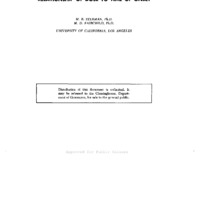-
Title
-
Subconvulsive Effects of 1, 1-Dimethylhydrazine on Locomotor Performance in the Cat: Relationship of Dose to Time of Onset
-
Date
-
1967
-
Index Abstract
-
Not Available
-
Photo Quality
-
Not Needed
-
Report Number
-
AMRL TR 67-66
-
Creator
-
Sterman, M. B.
-
Fairchild, M. D.
-
Corporate Author
-
University of California, Los Angeles
-
Laboratory
-
Aerospace Medical Research Laboratories
-
Extent
-
20
-
Identifier
-
AD0664549
-
Access Rights
-
Distribution of this document is unlimited. It may be released to the Clearinghouse, Department of Commerce, for sale to the general public.
-
Distribution Classification
-
1
-
Contract
-
AF 33(615)-2822
-
DoD Project
-
6302
-
DoD Task
-
630202
-
DTIC Record Exists
-
Yes
-
Distribution Change Authority Correspondence
-
None
-
Distribution Conflict
-
No
-
Abstract
-
Several recent neurophysiological findings in the study of 1, 1- dimethylhydrazine toxicity have suggested that this substance initiates a gradual increase in central nervous system (CNS) excitability, leading eventually to general convulsions. This process, however, is periodically interrupted by episodes of recovery or suppression of excitability. In the present experiment an attempt was made to investigate the nature of this alternation in response to low doses of UDMH, using the performance of a locomotor task as a measure of CNS effects. Cats were trained and tested in a special runway apparatus to provide a reliable indication of performance changes over a 6 hour period following the administration of 4, 8, and 16 mg/kg UDMH. These low doses significantly altered locomotor performance in a predictable manner. The response to a given dose was both consistent and unique to that dose. Within the 6 hour period of measurement, 16 mg/kg caused a gradual reduction in performance velocity leading to a total disruption, which was then followed by a tendency to recover; 8 mg/kg produced a recurrent depression of velocity followed by an enhancement, and 4 mg/kg resulted in a biphasic depression facilitation response. Other more general findings are also discussed.
-
Report Availability
-
Full text available
-
Date Issued
-
1967-09
-
Provenance
-
RAF Centre of Aviation Medicine
-
Type
-
report
-
Format
-
1 online resource
 AMRLTR67-066.pdf
AMRLTR67-066.pdf